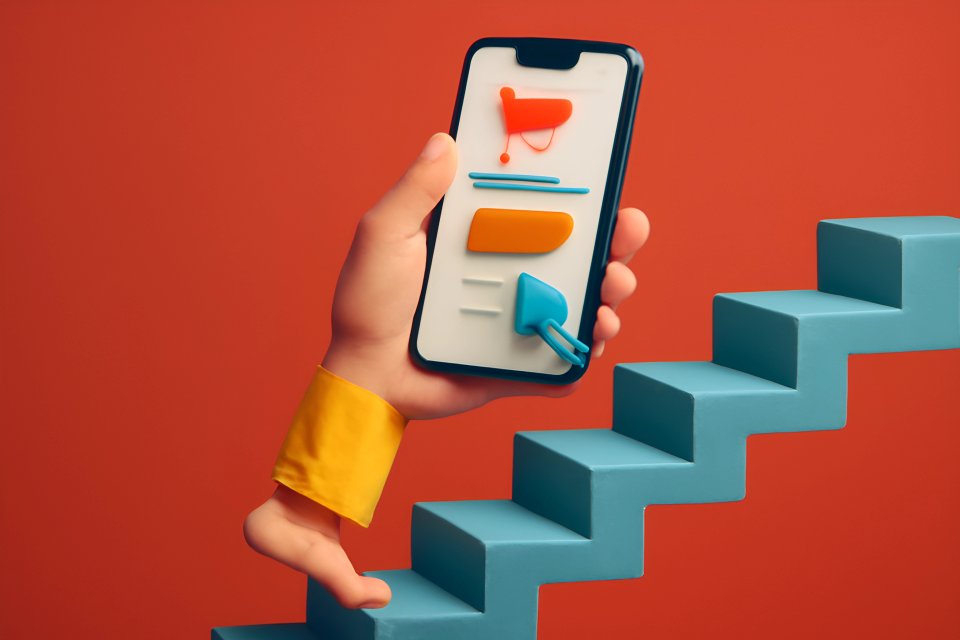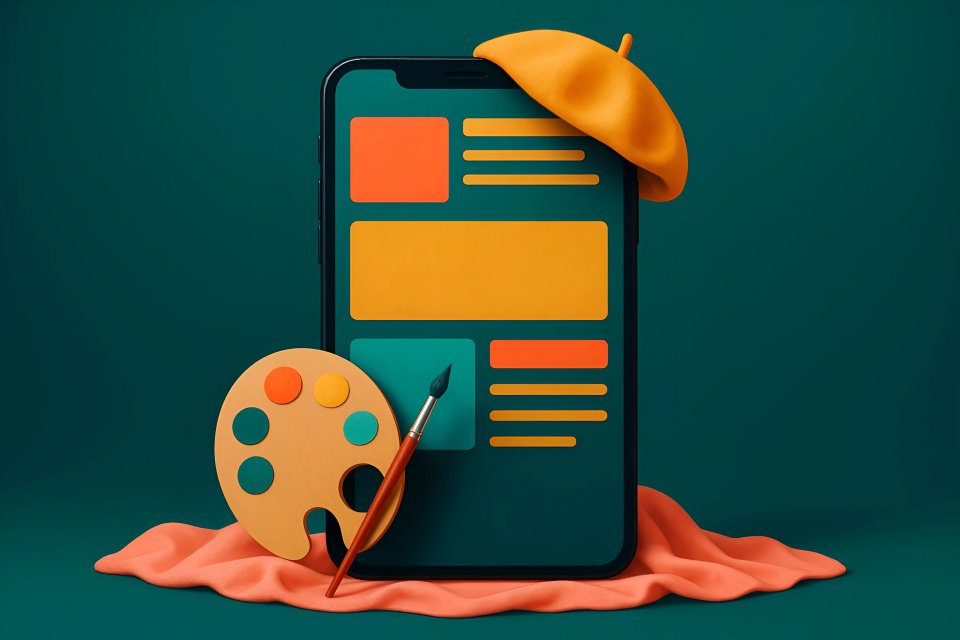Did you know that nearly 70% of online shopping carts are abandoned? Think about that. Seven out of every ten potential customers who add your product to their cart vanish before they pay you. The culprit often isn't your product or your price—it's a confusing, frustrating, and untrustworthy user experience.
You pour money into ads, driving traffic to your digital doorstep. But if your website is a maze of dead ends and confusing signs, you're not just losing sales; you're burning cash. This is the painful disconnect that keeps so many e-commerce businesses from reaching their true potential.
But what if you could fix the leaks in your sales funnel? The key to unlocking explosive growth lies in a strategic fusion of user-interface (UI) and user-experience (UX) design. This guide provides the exact step-by-step framework for crafting intuitive UI/UX for high-converting e-commerce sites, turning fleeting visitors into fiercely loyal customers.
Step 1: Laying the Foundation with User-Centered Research
Stop. Before you pick a single color or font, you must understand who you're selling to. Great design doesn't start with pixels; it starts with people. This is the heart of user-centered design, and it's the only way to build a site that truly connects and converts.
Develop Detailed User Personas
Who is your ideal customer? You can't just guess. User personas are detailed profiles of your target buyers, built not on assumptions, but on cold, hard data.
To build them, you must dig deep. Use customer surveys, conduct one-on-one interviews, and dive into your website analytics. The goal is to create a living document that represents a real person with real motivations, fears, and desires. According to HubSpot, businesses that exceed their revenue goals are more than twice as likely to use personas, proving that understanding your customer is the first step to winning their business. This foundational work is essential for optimizing conversion rates with user-centric design.
Map the Customer Journey
Once you know who your customer is, you need to understand their path. A customer journey map visualizes every single interaction a user has with your brand, from the first ad they see to the post-purchase follow-up email. It’s your blueprint for empathy.
Identify and scrutinize every key touchpoint: awareness, consideration, purchase, retention, and advocacy. Where do they feel friction? Where do they feel delight? As the Shopify Blog often highlights, mapping this journey reveals critical opportunities to improve the experience and guide users smoothly toward the sale.
Analyze User Behavior with Data
Personas tell you who your users are, but data tells you what they do. Tools like Google Analytics, heatmaps, and session recordings are your secret window into the user's mind. They show you exactly where people click, where they get stuck, and where they drop off.
Don't just look at the numbers; look for the patterns. Are users ignoring your main call-to-action? Are they rage-clicking on an element that isn't a button? The Google UX Playbook for Retail is built on this principle: data-backed insights lead to better design decisions and, ultimately, more revenue.
Step 2: Building the Blueprint: Information Architecture & Seamless Navigation
Let’s be brutally honest. A user who can't find what they're looking for can't buy it. A confusing website is a closed wallet. A logical, predictable site structure is the steel backbone of an intuitive experience that builds trust and drives sales.
Design a Clear and Scalable Sitemap
Your sitemap is the architectural plan for your entire website. It organizes your content into a logical hierarchy, making it effortless for both human users and search engine crawlers to understand and navigate your store. A well-structured site isn't just good for users; it's a critical component of technical SEO.
Think of your main categories as the foundational pillars of your store. From there, subcategories should branch out in a way that feels natural and predictable to your user personas. This clarity is fundamental, as it directly impacts how easily customers find products and how well you rank in search results, a key point explored in the impact of technical optimization on SEO rankings.
Master Your Navigation Menu
Your main navigation menu is the most powerful tool on your website. It must be simple, clear, and instantly understandable. Use straightforward labels like "Men's," "Women's," or "Electronics" instead of clever but confusing marketing jargon.
For stores with large inventories, a well-designed mega menu can be a game-changer, displaying multiple levels of categories at a glance without overwhelming the user. According to research highlighted by Smashing Magazine, poor navigation is a primary reason visitors leave a site. Your goal is to make finding products feel effortless, not like a treasure hunt.
Implement a Powerful On-Site Search
When a visitor uses your search bar, they are telling you exactly what they want to buy. This is a high-intent, high-value action you cannot afford to mess up. A weak search function is a direct path to a competitor's website.
Your on-site search must be more than a simple box. It needs intelligent features like auto-complete suggestions, the ability to handle typos, and robust filtering options to narrow down results. The experts at the Baymard Institute have found that users who engage with site search convert at a much higher rate, making a powerful search function a core pillar of effective e-commerce UI/UX design.
Step 3: Designing for Delight: UI Best Practices that Drive Action
Now we get to the part that most people think of as "design." This isn't just about making things look pretty; it's about using visual cues to build trust, create desire, and guide the user's hand directly to the Add to Cart button. This is where you turn a functional site into a persuasive one.
Establish a Strong Visual Hierarchy
What is the single most important action you want a user to take on any given page? Your design must answer that question instantly. Visual hierarchy uses elements like size, color, contrast, and placement to draw the eye to what matters most.
Your "Add to Cart" or "Buy Now" button should be the most visually dominant element on a product page, impossible to miss. Headlines should be larger than subheadings, which should be larger than body text. This creates a clear path for the user's eye to follow, reducing cognitive load and making the journey to purchase feel intuitive and guided, a concept central to many innovative e-commerce web design trends.
Prioritize High-Quality Visuals
You can't touch, feel, or try on a product online. Your visuals have to do all the heavy lifting. Grainy, low-quality product photos scream "untrustworthy" and will kill your conversion rates before a user even reads your description.
Invest in professional product photography from multiple angles. Use 360-degree views and short product videos to showcase features and build the confidence needed to make a purchase. Data consistently shows that visual appearance is a key deciding factor for the vast majority of online shoppers, making high-quality imagery a non-negotiable investment.
Embrace a Mobile-First Design Philosophy
Your customer is on their phone. Mobile commerce isn't a trend; it's the present and the future, with mobile sales now accounting for a massive slice of the e-commerce pie. Designing your site for a large desktop screen and then trying to shrink it down is a recipe for disaster.
A mobile-first approach forces you to prioritize what's truly essential. By designing for the smallest screen first, you ensure a clean, fast, and seamless experience for every user, regardless of their device. This is especially critical for the final steps of the sale, making it vital to focus on optimizing mobile checkout processes for maximum conversion rates.
Step 4: The Conversion Engine: Optimizing Key E-commerce Pages
This is where strategy meets execution. A beautiful design is useless if it doesn't convert. We will now apply our UI/UX principles directly to the most critical, money-making pages on your site to build a powerful conversion engine.
The Homepage: Your Digital Storefront
Your homepage has one job: to convince visitors to stay. It must immediately answer three questions: Who are you? What do you sell? And why should I care? A clear value proposition, prominently displayed, is essential.
Feature your best-selling products or most popular categories to guide users deeper into your site. Sprinkle in trust signals like customer testimonials, media mentions, or security badges to build instant credibility. Your homepage is your first impression; make it count by following the principles of designing an e-commerce website that converts.
Product Listing Pages (PLPs): Making Browsing Easy
This is your digital showroom. A cluttered and confusing product listing page will send shoppers running. The key here is to make browsing and comparison as easy as possible.
Implement robust filtering and sorting options. Allow users to filter by price, size, color, rating, and any other attribute relevant to your products. A Quick View function can also reduce friction, allowing users to see product details without leaving the page.
Product Detail Pages (PDPs): Sealing the Deal
This is where the sale is won or lost. Your product detail page must be a masterclass in persuasion. Start with compelling product descriptions that focus on benefits, not just features.
Your call-to-action—your Add to Cart button—must be bold, clear, and positioned above the fold. Surround it with social proof like customer reviews and star ratings. Be transparent about shipping costs and return policies to eliminate last-minute hesitation and build the trust needed to close the deal.
The Shopping Cart & Checkout: The Final Hurdle
You've done the hard work to get the customer this far. Don't lose them now with a clunky, complicated checkout process. Friction is your enemy here.
Offer a Guest Checkout option. Research from the Baymard Institute shows that forcing users to create an account is a primary cause of cart abandonment. Display security badges prominently, provide multiple payment options, and break the process into simple, logical steps to guide the user across the finish line. This is the final, and most important, application of expert conversion optimization techniques.
Step 5: Test, Measure, and Iterate for Continuous Growth
A high-converting website is never "finished." The market changes, customer expectations evolve, and your competitors are always trying to catch up. The only way to stay ahead is to adopt a mindset of continuous, data-driven improvement.
The Power of A/B Testing
Never rely on guesswork. A/B testing is the scientific method for conversion optimization. It allows you to test one change at a time—a different headline, a new button color, a revised page layout—to see what actually moves the needle.
Test your assumptions relentlessly. Does a green button really outperform a red one? Does a shorter form increase sign-ups? Every test provides a valuable lesson, turning your website into a perpetual optimization machine. For those ready to dive deep, exploring innovative A/B testing techniques for e-commerce is the logical next step.
Gather Qualitative Feedback
A/B testing tells you what is happening, but qualitative feedback tells you why. Use simple tools like on-site surveys and feedback polls to ask users directly about their experience. You'll be amazed at the insights you uncover.
According to the Nielsen Norman Group, the ROI on UX activities can be astronomical because you're solving real problems that prevent sales. Combining this "why" with your quantitative data is the key to mastering conversion optimization from visitor analysis to actionable A/B testing and achieving sustainable growth.
Conclusion: Intuitive Design Isn't an Expense—It's an Investment
Let's bring it all together. You start by deeply understanding your user. You build a logical structure that makes finding products effortless. You design a clean, trustworthy interface that guides their actions, optimize your key pages for conversion, and then you test and refine everything, forever.
This isn't just about aesthetics. This is about psychology, strategy, and revenue. Investing in intuitive UI/UX for your high-converting e-commerce site is the single most powerful and sustainable way to increase sales, build unshakable brand loyalty, and secure your long-term success in a competitive market.
Feeling overwhelmed? Transforming your e-commerce experience doesn't have to be a solo journey.
At CaptivateClick, we specialize in crafting captivating designs and strategic marketing that turn visitors into customers. Our global team of experts is ready to help you build a high-converting e-commerce site that stands out.
Contact us today for a free consultation and let's build a better brand, together.













